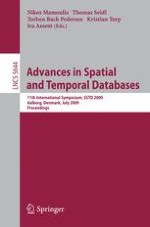2009 | OriginalPaper | Buchkapitel
Analyzing Trajectories Using Uncertainty and Background Information
verfasst von : Bart Kuijpers, Bart Moelans, Walied Othman, Alejandro Vaisman
Erschienen in: Advances in Spatial and Temporal Databases
Verlag: Springer Berlin Heidelberg
Aktivieren Sie unsere intelligente Suche, um passende Fachinhalte oder Patente zu finden.
Wählen Sie Textabschnitte aus um mit Künstlicher Intelligenz passenden Patente zu finden. powered by
Markieren Sie Textabschnitte, um KI-gestützt weitere passende Inhalte zu finden. powered by
A key issue in clustering data, regardless the algorithm used, is the definition of a distance function. In the case of trajectory data, different distance functions have been proposed, with different degrees of complexity. All these measures assume that trajectories are error-free, which is essentially not true. Uncertainty is present in trajectory data, which is usually obtained through a series of GPS of GSM observations. Trajectories are then reconstructed, typically using linear interpolation. A well-known model to deal with
uncertainty
in a trajectory sample, uses the notion of
space-time prisms
(also called
beads
), to estimate the positions where the object could have been, given a maximum speed. Thus, we can replace a (reconstructed) trajectory by a necklace (intuitively, a
a chain of prisms
), connecting consecutive trajectory sample points. When it comes to clustering, the notion of uncertainty requires appropriate distance functions. The main contribution of this paper is the definition of a distance function that accounts for uncertainty, together with the proof that this function is also a metric, and therefore it can be used in clustering. We also present an algorithm that computes the distance between the chains of prisms corresponding to two trajectory samples. Finally, we discuss some preliminary results, obtained clustering a set of trajectories of cars in the center of the city of Milan, using the distance function introduced in this paper.
